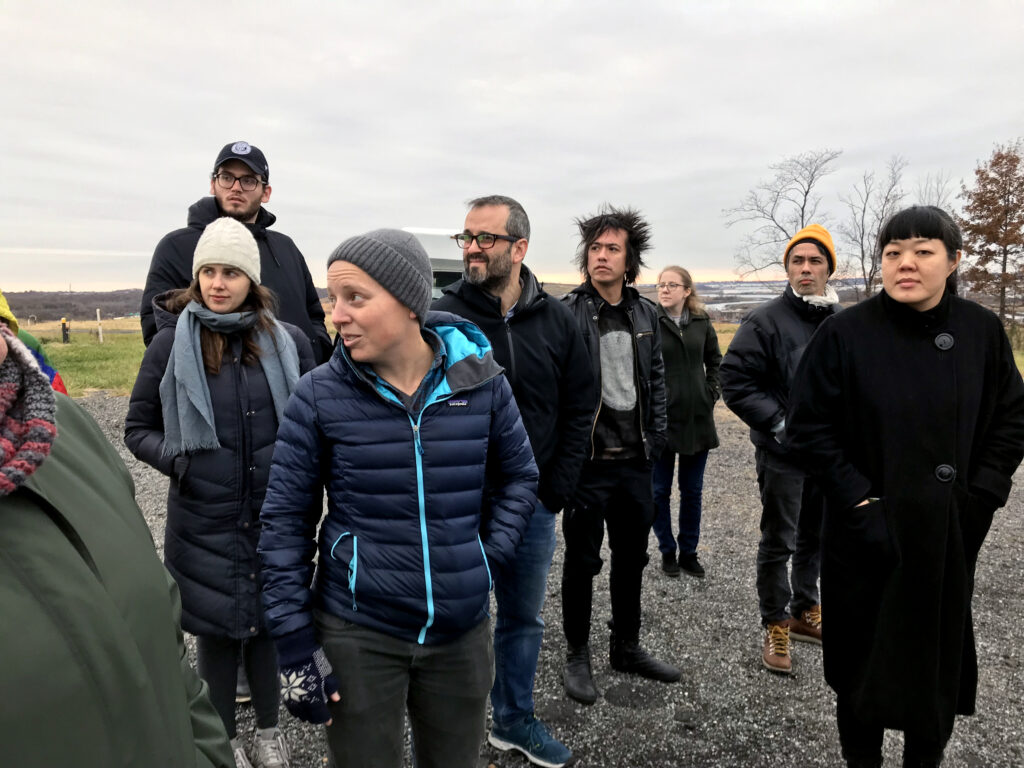
Cait Field (foreground) discusses grassland habitat changes with tour participants. Photo courtesy Lize Mogel.
As the Freshkills Park Manager for Science and Research Development, my role entails overseeing the scientific research program at the Park. This includes both coordinating with researchers from area institutions on projects ranging from plant surveys to bird banding to evaluating park goers’ attitudes about the site and leading some of our own internal research projects aimed at tracking the ecological changes taking place and incorporating those into management and development plans. At a site undergoing a massive environmental transformation, the majority of these projects fall under the “ecology” umbrella and most commonly are worked on by researchers from Biology departments.
Freshkills Park is a human-engineered “natural” landscape of massive proportions, plopped down in the largest city in the country. My favorite part about Freshkills Park is just how complicated it is – how such a beautiful landscape is created upon decades of our collective waste and how even with its beauty and ecological improvements, those years of blight are still part of its history and the natal wetland habitat that blanketed the site before its days as a landfill is still largely destroyed. Freshkills Park can be a feel-good story about what human can do to clean up their messes, but it is also inextricably a story of the damages that humans continue to enact on their environment.
My involvement with Field R/D was a natural fit, not despite my scientific role with Freshkills Park but because of it. How to conceptualize such a place is unprecedented and I see much of the scientific work happening at Freshkills as aimed at asking questions of what the site wants to become. How can formerly blighted lands increase their ecological services? What is changing ecologically at the site for the better and how can we encourage those changes to persist? For example, rare grassland bird species have begun to nest at the Park. They were not introduced – they came on their own as a result of the ~1,000 acres of newly created grassland habitat, the most critically endangered habitat worldwide. What we now ask as researchers is what we can do to encourage them to stay and to make them more successful. These types of questions are mirrored in those asked by the Field R/D artists, who turned to the Freshkills Park site to explore what art means in a place like this, what types of projects are possible, and what we can learn about the future of Freshkills Park by exploring responses to these projects.
I was fortunate to participate quite closely with some of the artists’ projects, like Lize Mogel’s site tours in 2018, where participants learned about the long-term and shorter-term ecological histories of the site and contemplated varying scales of ecological time. While accompanying those tours and sharing with participants the habitat changes occurring on site, I found that the content and delivery of my explanations were not all that different from the many tours I have led for various ecology courses and researchers. The process of thinking about changes and possibilities at Freshkills Park is shared across disciplines and there is much to learn across fields about how we can better ask and study these questions. Through the Field R/D project, artists asked a wide array of questions about the complexity of this place and through their site visits and conversations with each other those questions evolved and expanded. Their projects allowed them to go more deeply into the questions of how to represent such a complex history and potentially even more complex future.
As I stated earlier, my favorite part about Freshkills is this complexity and the ways that it causes us to re-imagine the frameworks of our thinking and expectations. We are pushed to think outside the box and I believe are more open to cross-disciplinary projects than we may be at more traditional venues and in more traditional roles. I am thankful for the opportunity that the Field R/D program gave me to expand my own thinking about what research can and should look like, particularly in these paradoxical spaces that are not bound as rigidly by expectations of what they should be.
————
Cait Field is the Manager for Science and Research Development at Freshkills Park. She recruits, coordinates, and consults on park research projects conducted by government and academic researchers related to ecology and ecological restoration. To complement work by partners, she develops the park team’s internal research projects including studies researching on fish health and diversity, grassland habitat management strategies, and citizen science water quality monitoring. She has developed and managed on- and off-site public programming relating to urban ecology at the park such as lecture series, birding programs, environmental sustainability outreach, and biodiversity survey events. Additionally, she assembled a Science Advisory Committee to identify research priorities and assist with positioning Freshkills Park as a leading site for ecological restoration research. Cait holds a BA in Neuroscience & Behavior from Vassar College, an MA in Animal Behavior & Conservation from Hunter College where she studied the sensory systems of cockroaches, and a PhD in Biopsychology & Behavioral Neuroscience from CUNY where her dissertation work focused on communication in electric fishes. Additionally, Cait is a US Coast Guard licensed captain with a 100 ton Masters License and has held a second career as a commercial sailing captain in NY harbor for over a decade, contributing to her strong interest in the ecology and health of our local waterways.